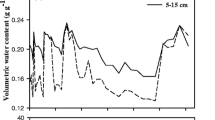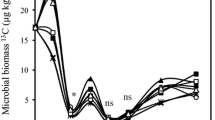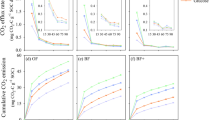Abstract
Various crops have been used for energy production while striving to maintain C storage derived from roots in soils. To better understand and document the rates of root decomposition in biofuel cropping systems, we compared the evolution of CO2 from roots incubated with samples of two Iowa Mollisols (Clarion and Nicollet). Root samples were collected from experimental plots for four cropping systems: a multispecies reconstructed prairie, grown with and without N fertilization, and continuous corn, grown with and without a ryegrass cover crop. Major structural components of the root samples (lignin, cellulose, and hemicellulose) as well as chemical composition (total C and N) were assessed. The root materials were incubated for 30 days at room temperature (22 °C) by using an incubation apparatus with continuous airflow. The decomposition rates and half-lives of rapidly and slowly decomposable C fractions were calculated by fitting a two-component first-order kinetic model to the data. Mineralizable C ranged from 7 to 13 % of the added C. When the data for the two soils were combined, the CO2-C evolved was positively correlated with both the C/N ratio (r = 0.88**, p < 0.01) and the lignin/N ratio (r = 0.89**, p < 0.01) of the roots. For the Clarion soil, first-order decomposition rate constants for the rapid fraction ranged from 0.07 to 0.69 day−1, whereas for the Nicollet soil they ranged from 0.09 to 0.66 day−1. For both soils, the half-lives of the rapidly decomposable fraction ranged from 1 to 10 days, and half-lives of 204 to 770 days were observed for the slowly decomposable fractions. Among the cropping systems studied, the rapidly decomposable fraction of roots derived from the unfertilized prairie treatment was the largest. Those root residues also had the highest hemicellulose index and higher concentrations of arabinose, galactose, glucose, and xylose sugars than did roots of the other crops. Other decomposition parameters, such as the decomposition rates and half-lives obtained from the two-component model, were not correlated with the root composition parameters studied. Our results suggest that lignin did not inhibit the early rate of root C mineralization in mixed perennial crops. That information could be useful in refining models of root C dynamics in daily time steps or at the scale of a single growing season.



Similar content being viewed by others
References
Abiven S, Recous S, Reyes V (2005) Mineralization of C and N from root, stem, and leaf residues in soil and role of their biochemical quality. Biol Fertil Soils 42:119–128
Ajwa H, Tabatabai MA (1994) Decomposition of different organic materials in soils. Biol Fertil Soils 18:175–182
Anderson-Teixeira KJ, Masters MD, Black CK, Zeri M, Hussain MZ, Bernacchi CJ, DeLucia EH (2013) Altered belowground carbon cycling following land-use change to perennial bioenergy crops. Ecosystems. doi:10.1007/s10021-012-9628-x
Bertrand I, Chabbert B, Kurek B, Recous S (2006) Can the biochemical features and histology of wheat residues explain their decomposition in soil? Plant Soil 281:291–307
Balesdent J, Balabane B (1996) Major contribution of roots to soil carbon storage inferred from corn cultivated soils. Soil Biol Biochem 28:1261–1263
Blagodatskaya Е, Kuzyakov Y (2008) Mechanisms of real and apparent priming effects and their dependence on soil microbial biomass and community structure: critical review. Biol Fertil Soils 45:115–131. doi:10.1007/s00374-008-0334-y
Broadbent F, Jackman R, McNicoll J (1964) Mineralization of carbon and nitrogen in some New Zealand allophanic soils. Soil Sci 98:118–128
Clark MD, Gilmour JT (1983) The effect of temperature on decomposition at optimum and saturated water contents. Soil Sci Soc Am J 47:927–929
Crawford RL (1981) Lignin biodegradation and transformation. Wiley, New York
Dungait JAJ, Hopkins DW, Gregory AS, Whitmore AP (2012) Soil organic matter turnover is governed by accessibility not recalcitrance. Glob Chang Biol 18:1781–1796
Gee GW, Or D (2002) Particle size analysis. In: Dane JH, Topp CG (Eds) Methods of soil analysis, Part 4. Physical methods. Soil Soc Am Book Ser 5. Madison, WI, pp 255–293
Ghidey F, Alberts EE (1993) Residue type and placement effects on decomposition: field study and model evaluation. Trans ASAE 36:1611–1617
Hatfield R, Grabber J, Ralph J, Brei K (1999) Using the acetyl bromide assay to determine lignin concentrations in herbaceous plants: some cautionary notes. J Agric Food Chem 47:628–632
Heal OW, Anderson JM, Swift MJ (1997) Plant litter quality and decomposition: an historical overview. In: Cadish G, Giller GE (eds) Driven by nature. Plant litter quality and decomposition. CABI, New York, pp 3–30
Hobbie SE (2008) Nitrogen effects on decomposition: a five-year experiment in eight temperate sites. Ecology 89:2633–2644
Jarchow ME, Liebman M (2012) Nitrogen fertilization increases diversity and productivity of prairie communities used for bioenergy. Glob Chang Biol Bioenergy 5:281–289. doi:10.1111/j.1757-1707.2012.01186.x
Jarchow ME, Liebman M, Rawat V, Anex RP (2012) Functional group and fertilization affect the composition and bioenergy yields of prairie plants. Glob Chang Biol Bioenergy 4:671–679. doi:10.1111/j.1757-1707.2012.01184.x
Jarchow M, Liebman M, Dhungel S, Dietzel R, Sundberg D, Anex R, Thompson ML, Chua T (2013) Tradeoffs among agronomic, energetic and environmental performance characteristics of corn and prairie bioenergy cropping systems. Glob Change Biol Bioenergy (in press)
Jeschke M, Heggenstaller A (2012) Sustainable corn stover harvest for biofuel production. Crop Insights 22:1–6. https://www.pioneer.com/home/site/us/agronomy/library/template.CONTENT/guid.4F38BFD2-972C-21E2-DCBB-1A36489D30B9#top
Johnson MF, Barbour NW, Weyer SL (2007) Chemical composition of crop biomass impacts its decomposition. Soil Sci Soc Am J 71:155–162
Lindedam J, Magid J, Poulsen P, Luxhøi J (2009) Tissue architecture and soil fertility controls decomposer communities and decomposition of roots. Soil Biol Biochem 41:1040–1049
Machinet GE, Bertrand I, Chabbert B, Matteau F, Villemin G, Recous S (2009) Soil biodegradation of corn root residues: interaction between chemical characteristics and the presence of colonizing micro-organisms. Soil Biol Biochem 41:1253–1261
Machinet GE, Bertrand I, Barriere Y, Chabbert B, Recous S (2011) Impact of plant cell wall network on biodegradation in soil: role of lignin composition and phenolic acids in roots from 16 corn genotypes. Soil Biol Biochem 43:1544–1552
Martens DA, Loeffelmann KL (2002) Improved accounting of carbohydrate carbon from plants and soils. Soil Biol Biochem 34:1393–1399
National Cooperative Soil Survey (2012) National Cooperative Soil Characterization Database. Available online at http://ncsslabdatamart.sc.egov.usda.gov
Nelson DW, Sommers LE (1996) Total carbon, organic carbon and organic matter. In: D. L. Sparks (Ed), Methods of soil analysis. Part 3. Chemical methods. Book Ser 5. Soil Sci Soc Am, Madison, pp 961–1010
Olk DC, Cassman KG, Schmidt-Rohr K, Anders MM, Mao JD, Deenik JL (2006) Chemical stabilization of soil organic nitrogen by phenolic lignin residues in anaerobic agroecosystems. Soil Biol Biochem 38:3303–3312
Rasse DP, Rumpel C, Dignac MF (2005) Is soil carbon mostly root carbon? Mechanisms for a specific stabilization. Plant Soil 269:341–356
Sánchez ÓJ, Cardona CA (2008) Trends in biotechnological production of fuel ethanol from different feedstocks. Bioresour Technol 99:5270–5295
Shi A, Penfold C, Marschner P (2013) Decomposition of roots and shoots of perennial grasses and annual barley—separately or in two residue mixes. Biol Fertil Soils 49:673–680
Sylvia DM, Hartel PG, Fuhrmann JJ, Zuberer DA (2005) Principles and applications of soil microbiology, 2nd edn. Pearson, Upper Saddle, pp 41–51
Tilston EL, Halpin C, Hopkins DW (2013) Decomposition of tobacco roots with modified phenylpropanoid content by fungi with contrasting lignocellulose degradation strategies. Biol Fertil Soils 49:305–311
Wright CK, Wimberly MC (2013) Recent land use change in the Western Corn Belt threatens grasslands and wetlands. Proc Natl Acad Sci U S A 110:4134–4139
Yanni SF, Whalen JK, Simpson MJ, Janzen HH (2011) Plant lignin and nitrogen contents control carbon dioxide production and nitrogen mineralization in soils incubated with Bt and non-Bt corn residues. Soil Biol Biochem 43:63–69
Zibilskie LM (1994) Carbon mineralization. In: Weaver RW, Angle JS, Bottomley PS (Eds) Methods of soil analysis, part 2, microbiological and biochemical properties. Book Ser 5. Soil Sci Am, Madison, pp 835–863
Acknowledgments
We gratefully acknowledge the technical support of T. Grimard and T. Chua in determination of acid-extractable monosaccharides and lignin, respectively. We thank the editor and two anonymous reviewers for their suggestions to improve the manuscript. The project was funded by the Plant Sciences Institute at Iowa State University and by the Carbon Cycle Science Program of the National Institute for Food and Agriculture, US Department of Agriculture.
Author information
Authors and Affiliations
Corresponding author
Electronic supplementary material
Below is the link to the electronic supplementary material.
ESM 1
(DOCX 18 kb)
Rights and permissions
About this article
Cite this article
Rivas, F.A., Tabatabai, M.A., Olk, D.C. et al. Kinetics of short-term carbon mineralization in roots of biofuel crops in soils. Biol Fertil Soils 50, 527–535 (2014). https://doi.org/10.1007/s00374-013-0870-y
Received:
Revised:
Accepted:
Published:
Issue Date:
DOI: https://doi.org/10.1007/s00374-013-0870-y




